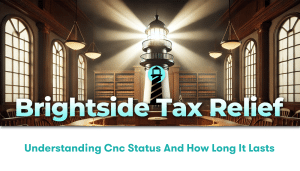Understanding an Offer in Compromise
An Offer in Compromise (OIC) is a settlement agreement between a taxpayer and the Internal Revenue Service (IRS) to resolve outstanding tax liabilities for less than the full amount owed. It is a powerful tool available to taxpayers facing substantial back taxes. However, the process of obtaining this agreement can be complex, and it’s essential to understand its do’s and don’ts before submitting an offer. As Brightside Tax Relief LLC, a nationwide tax relief company, we have the expertise and experience to explain these points comprehensively.
The Advantages of an Offer in Compromise
An OIC carries multiple benefits for the taxpayer in debt. It allows you to pay your taxes in manageable chunks, eliminates worries of wage garnishments or tax liens, and you can avoid the penalties and fees that accrue with unpaid taxes. In offering a lower settlement, the IRS acknowledges that the agreed amount is the most it can expect to collect from you within a reasonable period.
Qualifications for an Offer in Compromise
While an OIC provides substantial relief, it demands equally specific qualifications. The IRS considers your ability to pay, income, expenses, and asset equity. They examine if the full payment might result in severe economic hardship or if there exists a doubt about liability (a dispute about the tax owed). Proof that you are incapable of paying the tax in full by the due date (by selling assets or borrowing) is paramount.
The Do’s of Submitting an Offer in Compromise
Meticulous Calculation
Accurate calculation of your offer plays an instrumental role. Too low, and it risks denial; too high, and you end up overspending. Work with tax professionals to accurately calculate what you can truly afford to pay, and start from that baseline.
Vigilant Form Filing
You should fill out all the necessary forms, including Form 656-B (the official OIC Booklet), with diligence. Completeness and accuracy are the keys to getting results.
Stay Up to Date on Tax Payments
You must also be current on all tax filings and payments. The IRS wants to see accountability and commitment to paying your current taxes on time.
Pay the Application Fee and Initial Payment
The OIC application requires a $205 non-refundable application fee. Depending on the payment option you choose, you’ll also need to make an initial payment towards your offer.
The Don’ts of Submitting an Offer in Compromise
Don’t Neglect to Explore Options
An OIC isn’t for everyone. It’s crucial to consider all debt resolution options before jumping into an Offer in Compromise.
Don’t Ignore Professional Help
Submitting an OIC demands intricate knowledge of tax laws and regulations, and any mistakes can lead to rejection. Enlisting a tax expert’s aid can be fruitful and help you navigate the process seamlessly.
Don’t Forget Documentation
You must include detailed financial information and documentation with your application for it to be considered valid. Skipping any required document can lead to rejection.
Don’t Hide Assets or Income
The IRS conducts a thorough investigation of your financial profile. So, any attempt to hide assets or income can cause severe repercussions.
Corporate with IRS During the whole Process
Throughout the OIC process, you should maintain honesty, transparency, and cooperation with the IRS. Remember to provide any additional information or documentation requested by them.
A Word from Brightside Tax Relief LLC
Navigating tax debts can be a daunting task, and the OIC process can become complicated without proper guidance. As Brightside Tax Relief LLC, we are committed to offering a wide range of tax services to resolve your IRS issues, including assistance with Offers in Compromise. Our team of tax professionals is always ready to guide you through the process and help you secure the best settlement possible.
Remember, while an Offer in Compromise can offer significant relief from tax debts, it is littered with numerous intricacies. Meticulous accuracy, correct calculations, vigilant documentation, and knowledgeable guidance can drastically increase the success chances of your OIC being accepted by the IRS. You don’t have to face these complexities alone. Contact Brightside Tax Relief LLC, and we’ll navigate this path together.




